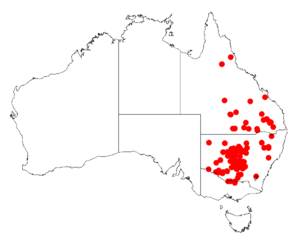Yarran facts for kids
Quick facts for kids Yarran |
|
|---|---|
 |
|
| Specimen growing near Nyngan, New South Wales, Australia. | |
| Scientific classification | |
 |
|
| Occurrence data from AVH | |
| Synonyms | |
|
The Yarran, also known as Acacia homalophylla, is a small tree. It grows mostly in the eastern parts of Australia. You can also find it in India and Pakistan, where it was brought by people.
What the Yarran Looks Like
The Yarran tree has a smooth trunk and a full, leafy top. Its bark is dark gray and rough. The leaves are narrow and usually straight. In spring, from August to October (sometimes November), it grows bright yellow flowers that look like small balls.
The leaves of the Yarran can be eaten and are used as fodder for animals. The tree also produces a sticky gum. Its wood, called myall-wood, is strong, smells nice, and is dark in color. Long ago, native people used this wood to make spears.
This tree or shrub can grow up to 7 meters (about 23 feet) tall. It can grow straight up or spread out, and it often sends up new shoots from its roots. Its young branches are smooth, but new growth might have a few tiny hairs. Like many Acacia species, the Yarran has phyllodes instead of true leaves. Phyllodes are flattened leaf stems that look and act like leaves.
The Yarran's phyllodes are evergreen and a grey-green color. They are narrow and can be straight or slightly curved. They are usually 4 to 11 centimeters (about 1.5 to 4.3 inches) long and 4 to 7 millimeters (about 0.15 to 0.27 inches) wide. They have many long veins, but these are often hard to see. Sometimes, three or more veins are clearer than the others.
The inflorescences (flower clusters) grow in groups of one to three where the leaves meet the stem. Each cluster has a round flower-head, about 4 to 6 millimeters (about 0.15 to 0.23 inches) across. These flower-heads contain 20 to 30 bright yellow flowers. After the flowers bloom, flat, papery to slightly leathery seed pods form. These pods are straight and can be up to 7 centimeters (about 2.7 inches) long and 3 to 7 millimeters (about 0.1 to 0.27 inches) wide.
Why It's Called Yarran
The scientific name homalophylla likely refers to how smooth the phyllodes are. They are flat and often look like they don't have any veins. When the botanist Bentham first wrote about this species, he spelled it omalophylla. Later, in 1864, he corrected it to homalophylla. However, some botanists and writers still use the older spelling.
Where the Yarran Grows
The Yarran tree is found in different places across Queensland, New South Wales, and Victoria in Australia. In New South Wales, you can find it west of Muswellbrook and Emmaville. It often grows with other trees like Casuarina cristata, rosewood, and box trees, usually in brown, earthy soils.
See also
- List of Acacia species

